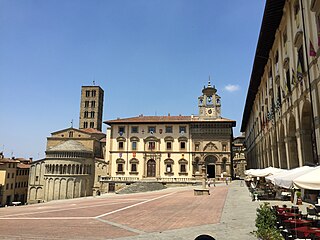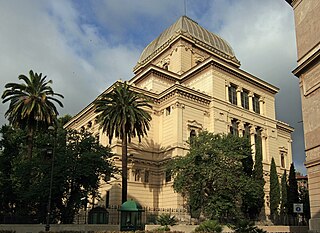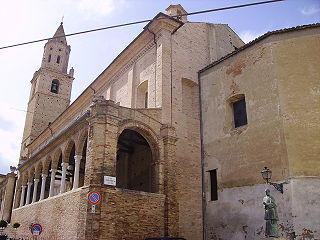
Trapani is a city and comune on the west coast of Sicily in Italy. It is the capital of the Province of Trapani. Founded by Elymians, the city is still an important fishing port and the main gateway to the nearby Egadi Islands.

Arezzo is a city and comune in Italy and the capital of the province of the same name located in Tuscany. Arezzo is about 80 kilometres southeast of Florence at an elevation of 296 metres (971 ft) above sea level. In 2013 the population was about 99,000.

The Venetian Lagoon is an enclosed bay of the Adriatic Sea, in northern Italy, in which the city of Venice is situated. Its name in the Italian and Venetian languages, Laguna Veneta—cognate of Latin lacus, "lake"—has provided the English name for an enclosed, shallow embayment of salt water, a lagoon.

Giudecca is an island in the Venetian Lagoon, in northern Italy. It is part of the sestiere of Dorsoduro and is a locality of the comune of Venice.

San Giorgio Maggiore is one of the islands of Venice, northern Italy, lying east of the Giudecca and south of the main island group. The island, or more specifically its Palladian church, is an important landmark. It has been much painted, featuring for example in a series by Monet.

Sant'Angelo is the 11th rione of Rome, Italy, located in Municipio I. Often written as rione XI - Sant'Angelo, it has a coat of arms with an angel on a red background, holding a palm branch in its left hand. In another version, the angel holds a sword in its right hand and a scale in its left.

Ripa is the 12th rione of Rome, identified by the initials R. XII, and it is located in the Municipio I.

Città Sant'Angelo is a city and comune in the province of Pescara, Abruzzo, Italy.

Castello is the largest of the six sestieri of Venice, Italy.

The Sacra di San Michele, sometimes known as Saint Michael's Abbey, is a religious complex on Mount Pirchiriano, situated on the south side of the Val di Susa in the territory of the municipality of Sant'Ambrogio di Torino, in the Metropolitan City of Turin, Piedmont region of northwestern Italy. The abbey, which for much of its history came under Benedictine rule, is now entrusted to the Rosminians.

San Giorgio in Alga is an island of the Venetian lagoon, northern Italy, lying between the Giudecca and Fusina.
Giorgio di Sant' Angelo , commonly known as Giorgio Sant'Angelo, (1933–1989) was an Italian/Argentinian fashion designer based in the United States. He was known for creating ethnic-inspired looks early in his career, for which he won the prestigious American Coty Fashion Critic's award in 1968 and in 1970. Using fabrics like tie-dyed chiffon, leather and cotton, he created romantic clothing that reflected the hippie culture of the era. But his innovative use of knitwear, which he continuously developed throughout his career, was often his signature and was an influence on other designers.

San Marco in Boccalama was an island, now submerged, in the Venetian Lagoon, northern Italy. It was located between Campana, Sant'Angelo della Polvere and the motte di Volpego. The name derived from the presence of a church dedicated to St. Mark, and to its location at the mouth the Lama, an old branch of the river Brenta's mouth.

Giovanni di Bernardo Rucellai was an Italian humanist, poet, dramatist and man of letters in Renaissance Florence, in Tuscany, Italy. A member of a wealthy family of wool merchants and one of the richest men in Florence, he was cousin to Pope Leo X and linked by marriage to the powerful Strozzi and de' Medici families. He was born in Florence, and died in Rome. He was the son of Bernardo Rucellai (1448–1514) and grandson of Giovanni di Paolo Rucellai (1403–1481). He is now remembered mostly for his poem Le Api, one of the first poems composed in versi sciolti to achieve widespread acclaim.

San Gregorio della Divina Pietà is a small Roman Catholic church facing the Piazza Gerusalemme located in Rione Sant'Angelo, in Rome, Italy. It is located near the Great Synagogue of Rome and the former Jewish quarter of Rome. It is sometimes referred to as San Gregorietto due to its small size. In the past, it was also called San Gregorio a Ponte Quattro Capi or Pons Judaeorum due to its proximity to the bridge known now as Pons Fabricius, connecting the sector to the Tiber island.

Angelo Italia was an Italian Jesuit and Baroque architect, who was born in Licata and died in Palermo. He designed a number of churches in Sicily, and later worked to reconstruct three cities following the 1693 Sicily earthquake.

Santi Biagio e Cataldo or San Biagio e Cataldo was a church on the western corner of the Giudecca island in Venice, Italy. It was dedicated to saint Blaise and saint Catald.
Ammiana was a settlement in an archipelago in the northern part of the Lagoon of Venice which has disappeared. Its islands were part of a larger number of islands in this part of the lagoon which also included the island group of the next-door settlement of Costanziaco and the islands of Torcello, Burano and Mazzorbo to the south-east. The islands of Ammiana were between the right and left banks of the lagunar channels which today are called della Dolce and San Felice. Another island, which was called tumba della Leseda and is now called La Salina, which lies on the right (eastern) bank of the San Felice channel, was also part of this settlement.

















